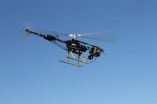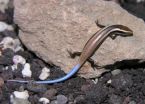(Press-News.org) WASHINGTON, April 30--Different types of compact, low-power portable sensors under development by three independent research groups may soon yield unprecedented capabilities to monitor ozone, greenhouse gases, and air pollutants. The three teams will each present their work at the Conference on Lasers and Electro-Optics (CLEO: 2012 (http://www,cleoconference.org)), to be held May 6-11, in San Jose, Calif.
Princeton University engineer Amir Khan and colleagues, working with space scientists at the University of Texas at Dallas, will discuss how their teams combined a compact, low-power, open-path (exposed directly to the environment) laser sensor with a robotic helicopter to measure the three most important greenhouse gases – carbon dioxide, methane and water vapor – in the atmosphere. The biggest advantage of the combination is that it provides high-resolution mapping in both the vertical and horizontal directions near emissions sources – something that ground-based networks or satellite-based sensors cannot do. Additionally, the sensor on the robotic helicopter is easy to deploy, inexpensive to operate, can be programmed to fly a preset monitoring pattern using GPS coordinates, and can handle challenging situations such as measuring emissions from industrial plants where the plumes move sideways as well as up.
A first-time demonstration of a system with the potential to become a portable, low-power, low-cost, and long-lasting optical sensor for ozone (O3) measurements will be presented by a team of engineers from the University of Rostock in Germany and Sensor Electronic Technology Inc. in South Carolina. The sensor uses light-emitting diodes (LEDs) to produce light in the deep ultraviolet range of the spectrum (wavelengths less than 300 nanometers) that allows the detection of small amounts of ozone – trace concentrations ranging anywhere from approximately 10 parts per billion to approximately 100 parts per million. The team showed in tests that this sensitivity compares favorably to conventional sensors that use less durable and more expensive mercury or electrochemical light sources. The team also discovered that coupling the deep ultraviolet LED to the detection equipment with fiber-optic cables produced a sturdy sensor that could be used in harsh environments, such as areas with strong electromagnetic fields, high temperatures, or strong vibrations.
Finally, engineer David Miller, also from Princeton University, will discuss his team's use of an open-path quantum cascade laser to create a portable sensor that can detect extremely small quantities of atmospheric ammonia (NH3) in harsh field environments. This molecule commonly forms unhealthy particulate matter, but measurements of this pollutant in the atmosphere are lacking. The Princeton sensor has performed well when deployed in harsh environments – everything from dusty deserts to jungle-like conditions to sub-freezing temperatures – providing an ability to measure concentrations of NH3 as small as 200 parts per trillion. Data from the high-sensitivity ammonia sensor will significantly improve air quality forecasts.
INFORMATION:
CLEO: 2012 presentation JTh1L.6 "Open-Path Greenhouse Gas Sensor for UAV Applications," by M. Amir Khan et al. is at 9:30 a.m. on Thursday, May 10 in the San Jose Convention Center.
CLEO: 2012 presentation JTh1L.1"Deep Ultraviolet LED-Based Ozone Sensor," by Yuri Bilenko et al. is at 8 a.m. on Thursday, May 10 in the San Jose Convention Center.
CLEO: 2012 presentation ATh3L.7 "Assessing Field Performance of an Open-Path Quantum Cascade Laser Sensor for Measuring Atmospheric Ammonia," by David J. Miller et al. is at 3:45 p.m. on Thursday, May 10 in the San Jose Convention Center.
EDITOR'S NOTE: A high-resolution image of the robotic helicopter is available to members of the media upon request. Contact Angela Stark, astark@osa.org.
Press Registration
A Press Room for credentialed press and analysts will be located on-site in the San Jose Convention Center, May 6 – May 11. Media interested in attending the conference should register on the CLEO website (http://www.cleoconference.org/home/news-and-press/press-and-analysts/press-and-analyst-registration-form.aspx) or contact Angela Stark at 202.416.1443, astark@osa.org.
About CLEO
With a distinguished history as the industry's leading event on laser science, the Conference on Lasers and Electro-Optics (CLEO) is where laser technology was first introduced. CLEO unites the field of lasers and electro-optics by bringing together all aspects of laser technology, with content stemming from basic research to industry application. CLEO: Expo showcases the latest products and applications from more than 300 participating companies from around the world, providing hands-on demonstrations of the latest market innovations and applications. The Expo also offers valuable on-floor programming, including Market Focus and the Technology Transfer program.
Sponsored by the American Physical Society's (APS) Laser Science Division, the Institute of Electronic Engineers (IEEE) Photonics Society and the Optical Society (OSA), CLEO provides the full range of critical developments in the field, showcasing the most significant milestones from laboratory to marketplace. With an unparalleled breadth and depth of coverage, CLEO connects all of the critical vertical markets in lasers and electro-optics. For more information, visit the conference's website at www.cleoconference.org.
Portable gas sensors improve atmospheric pollution measurements
2012-04-30
ELSE PRESS RELEASES FROM THIS DATE:
24 new species of lizards discovered on Caribbean islands are close to extinction
2012-04-30
In a single new scientific publication, 24 new species of lizards known as skinks, all from islands in the Caribbean, have been discovered and scientifically named. According to Blair Hedges, a professor of biology at Penn State University and the leader of the research team, half of the newly added skink species already may be extinct or close to extinction, and all of the others on the Caribbean islands are threatened with extinction. The researchers found that the loss of many skink species can be attributed primarily to predation by the mongoose -- an invasive predatory ...
New research expands understanding of psychoactive medication use among children in foster care
2012-04-30
Philadelphia -- A few months after the federal Government Accountability Office (GAO) issued a report on the use of psychoactive drugs by children in foster care in five states, a national study from PolicyLab at The Children's Hospital of Philadelphia describes prescription patterns over time in 48 states. The updated findings show the percentage of children in foster care taking antipsychotics--a class of psychoactive drugs associated with serious side effects for children-- continued to climb in the last decade. At the same time, a slight decline was seen in the use ...
Agroforestry is not rocket science but it might save DPR Korea
2012-04-30
KOREA (30 April 2012) — There is more going on in DPR Korea than rocket science: local people in collaboration with natural resources scientists are taking control of their food supply through agroforestry. This is according to a report published in Agroforestry Systems journal.
How participatory agroforestry restored land and secured the food supply
The report published online on 24 March, notes that in DPR Korea a bottom–up participatory process of developing locally appropriate agroforestry has been a revelation to many and is helping to reverse the chronic food ...
Scientists uncover exciting lead into premature aging and heart disease
2012-04-30
Scientists have discovered that they can dramatically increase the life span of mice with progeria (premature ageing disease) and heart disease (caused by Emery-Dreifuss muscular dystrophy) by reducing levels of a protein called SUN1. This research was done by A*STAR's Institute of Medical Biology (IMB) in collaboration with their partners at the National Institute of Allergy and Infectious Diseases in the United States and the Institute of Cellular and System Medicine in Taiwan. Their findings were published in the prestigious scientific journal, Cell, on 27th April 2012 ...
Antarctic albatross displays shift in breeding habits
2012-04-30
A new study of the wandering albatross – one of the largest birds on Earth – has shown that some of the birds are breeding earlier in the season compared with 30 years ago.
Reporting online this month (April) in the journal Oikos, a British team of scientists describe how they studied the breeding habits of the wandering albatross on the sub-Antarctic island of South Georgia. They have discovered that because some birds are now laying their eggs earlier, the laying date for the population is an average of 2.2 days earlier than before.
The researchers say the reasons ...
Arabic records allow past climate to be reconstructed
2012-04-30
Corals, trees and marine sediments, among others, are direct evidence of the climate of the past, but they are not the only indicators. A team led by Spanish scientists has interpreted records written in Iraq by Arabic historians for the first time and has made a chronology of climatic events from the year 816 to 1009, when cold waves and snow were normal.
The Arabic historians' records chronologically narrate social, political and religious matters, and some of them mention climate. A study led by researchers from the University of Extremadura (Spain) has focused on ancient ...
Superconducting strip could become an ultra-low-voltage sensor
2012-04-30
Researchers studying a superconducting strip observed an intermittent motion of magnetic flux which carries vortices inside the regularly spaced weak conducting regions carved into the superconducting material. These vortices resulted in alternating static phases with zero voltage and dynamic phases, which are characterised by non-zero voltage peaks in the superconductor. This study, which is about to be published in EPJ B¹, was carried out by scientists from the Condensed Matter Theory Group of the University of Antwerp, Belgium, working in collaboration with Brazilian ...
Obesity affects job prospects for women, study finds
2012-04-30
Obese women are more likely to be discriminated against when applying for jobs and receive lower starting salaries than their non-overweight colleagues, a new study has found.
The study, led by The University of Manchester and Monash University, Melbourne, and published in the International Journal of Obesity, examined whether a recently developed measure of anti-fat prejudice, the universal measure of bias (UMB), predicted actual obesity job discrimination. The researchers also assessed whether people's insecurity with their own bodies (body image) and conservative personalities ...
Magnetic resonance imaging with side effects
2012-04-30
Great care should be taken when performing magnetic resonance imaging (MRI) in patients with a cardiac pacemaker. Henning Bovenschulte and his co-authors review recent findings in the latest issue of Deutsches Ärzteblatt International (Dtsch Arztebl Int 2012; 109[15]: 270-5).
MRI is generally contraindicated in patients with a pacemaker (PM) or an implantable cardiac defibrillator (ICD), because of the risk of life-threatening events. The devices and their sensors may interact with the magnetic fields, disrupting the cardiac rhythm. Energy builds up in the electrode leads, ...
Old star, new trick
2012-04-30
Pasadena, CA—The Big Bang produced lots of hydrogen and helium and a smidgen of lithium. All heavier elements found on the periodic table have been produced by stars over the last 13.7 billion years. Astronomers analyze starlight to determine the chemical makeup of stars, the origin of the elements, the ages of stars, and the evolution of galaxies and the universe. Now for the first time, astronomers have detected the presence of arsenic and selenium, neighboring elements near the middle of the periodic table, in an ancient star in the faint stellar halo that surrounds ...


